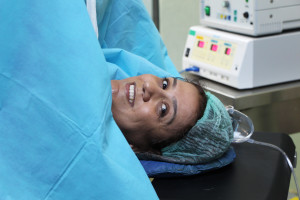Extraperitoneal Cesarean: What You Need to Know
 Extraperitoneal cesarean surgery is a procedure that dates before the antibiotics were available. At the time, its advantage was decreased morbidity and risk of infection by avoiding opening the peritoneal sac. Because this procedure is more difficult to perform; it was abandoned for the more traditional cesarean section technique. However, there are some instances where this technique is still useful today. Only a small number of OBGYNs across the nation are trained and qualified to safely perform the operation, among which is our very own Dr. Sayegh. Read on to find out if you might be a candidate for this procedure.
Extraperitoneal cesarean surgery is a procedure that dates before the antibiotics were available. At the time, its advantage was decreased morbidity and risk of infection by avoiding opening the peritoneal sac. Because this procedure is more difficult to perform; it was abandoned for the more traditional cesarean section technique. However, there are some instances where this technique is still useful today. Only a small number of OBGYNs across the nation are trained and qualified to safely perform the operation, among which is our very own Dr. Sayegh. Read on to find out if you might be a candidate for this procedure.
Common Forms of Cesarean Surgery: Classic and Low
In a classic cesarean surgery, a doctor makes an incision through the mother’s lower abdomen. A second incision is made in the uterus from which the baby is removed. Alternatively, a low cervical cesarean section is a procedure in which a baby is delivered through a transverse incision in the thin supracervical part of the lower uterine segment, an area located behind the bladder and the bladder flap. Compared to a classical cesarean section, the incision made in a low cervical cesarean section bleeds less during surgery and heals with a stronger scar.
What is Extraperitoneal Cesarean Surgery?
In an extraperitoneal cesarean surgery, an incision is made in the lower uterine segment that does not require entering the peritoneal cavity. With this method, the uterus is approached through the paravesical space and the baby, placenta, and membranes are all removed via the uterus incision.
What are the Benefits of Extraperitoneal Cesarean Surgery?
While cesarean surgery is often necessary for situations in which a natural birth is not possible, such as complications with the placenta, multiple births, or a chronic health condition such as high blood pressure, there are still risks involved for mothers and babies with any surgical approach. One of the most significant concerns is that of infection. Cesarean surgeries are by their nature, invasive which causes a risk of infection. The extraperitoneal cesarean surgery method helps to minimize the risk of an infection spreading from the uterus into the peritoneal cavity. Keeping the peritoneum intact prevents the spread of infection.
With this less invasive approach, other advantages include less pain and a faster recovery. Patients experience no nausea, and reduced post-surgical pain and discomfort, which allows for a more comfortable healing process for the new mother. Also, there is reduced possible trauma to the bladder with this procedure.
Who are the Best Candidates for this Procedure?
Not everyone is a candidate for this type of surgery. So who would benefit from an extraperitoneal cesarean? Typically, this procedure would be best for a patient with infection during labor, such as chorioamnionitis, a patient with previous bowel surgeries or bowel obstruction, and patients with known adhesions.
We are proud to provide our patients with the very best in treatment methods to help ensure a new generation of Western New York babies is brought into this world safely. For women who may require a cesarean section, your OBGYN will help you determine if an extraperitoneal cesarean is right for you.
If you have questions about Extraperitoneal Cesarean Surgery available from our practice, and whether it may be appropriate for you, contact us today.
More